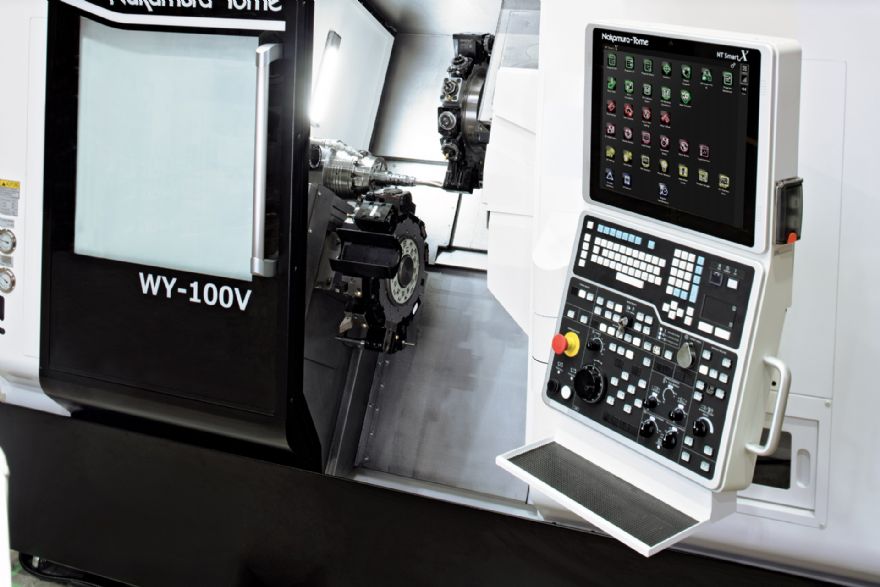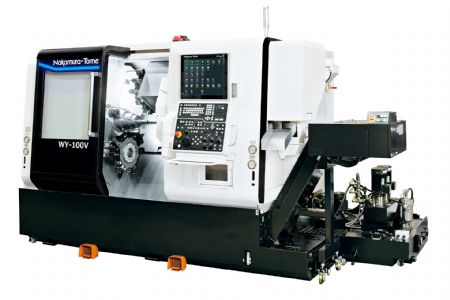
At
EMO Hannover 2023 which took place in September, Nakamura-Tome CEO Shogo Nakamura described how the company is making the Nakamura-Tome WY-100V turning centre, available in the UK from the Wellesbourne-based
Engineering Technology Group (ETG), even faster.
The new flagship machine is a twin-spindle twin turret turning centre with both turrets offering Y-axis capability. With ‘V’ in the machine name denoting ‘Velocity’, Shogo Nakamura said: “It enables faster cycle times that enable customers to make more workpieces in a shorter time. This machine will alleviate the problems of delivery time and it delivers the possibility of reducing costs.”
Looking at the particular hydraulic component that was machined at
EMO 2023 in a single operation with complex milling, drilling and turning cycles, Mr Nakamura explained how the part is being machined with a 30% cycle time reduction - taking the cycle time from 536 to just 375sec. It is achieved with the new unique ChronoCut software technology that eliminates non-productive time for the customer. One example of how significant time savings can be made was demonstrated on holes drilled around the periphery of the hydraulic component with both turrets drilling simultaneously to reduce the drilling cycle time by 56%.
This was followed by the rigid tapping of eight holes on the face of the turned part. The ChronoCut technology tapped the holes at 4,000rev/min and then retracted the taps at 8,000rev/min, conducting very high-speed synchronisation of the Z-axis travel with the milling rotation. Previously, the maximum synchronising rotation speed during rigid tapping was around 3,000rev/min, but with ‘V’, it is now possible to synchronise up to 8,000rev/min.

The demonstration then highlighted the synchronisation of spindle rotation between main and sub-spindle and also the B2-axis travel that parted-off the part with the sub-spindle subsequently gripping and collecting the part for secondary operations while the component was being parted off. Mr Nakamura added: “Software normally provides usability and operator-friendly functions, but with ChronoCut, we have software that changes the movement of the machine to make it faster and faster - this is the revolution.”
Fundamentally, ChronoCut is a software system that encompasses a comprehensive suite of idle-time reduction technologies developed by Nakamura-Tome. It includes a range of ingenious mechanical and engineering innovations, such as quick C-axis positioning, high-speed rigid tapping, faster spindle synchronisation, high-speed indexing, improved speed of part catcher and type-G motion, shorter milling stop times, high-speed part transfer and multiple M code execution. In fact, ChronoCut incorporates over 15 different technologies.
The compact machine also offers increased acceleration with chip-to-chip times of just 0.7sec. With the WY-100V turning centre, Nakamura has also redesigned the machine bed, spindle box, milling structure and indexing structure which includes a new compact turret design. Unlike larger turrets, the compact and powerful turret design enables customers to reach the edge of the chuck and workpiece - removing the restrictions of machining while offering 10,000rev/min milling. This high-speed milling capability not only improves productivity, performance and surface finishes - it also removes the need for secondary hand finishing. This can be achieved by applying deburring cycles to remove burrs from components.
Looking at the precision level of the WY-100V machine, Shogo Nakamura emphasises how the company has incorporated new materials in several units of the machine to increase thermal stability. This is complemented by the new NT Thermo Navigator system, which was demonstrated at
EMO with a part machined in the morning and inspected with one feature measuring 35.468mm. It was inspected again eight hours later with a measurement of 35.471mm - a deviation of just 3µm over an 8hr shift.